You can replace deer musk in DIY fragrances with several ethical alternatives. Natural options include ambrette seed absolute, angelica root, and labdanum resin, which provide similar musky undertones. For synthetic alternatives, try white musks like galaxolide or cashmeran. You can also blend essential oils like patchouli, vetiver, and amber to create complex musk-like aromas. Let's explore how to craft these musk alternatives step by step.
Understanding Natural Musk and Why We Need Alternatives
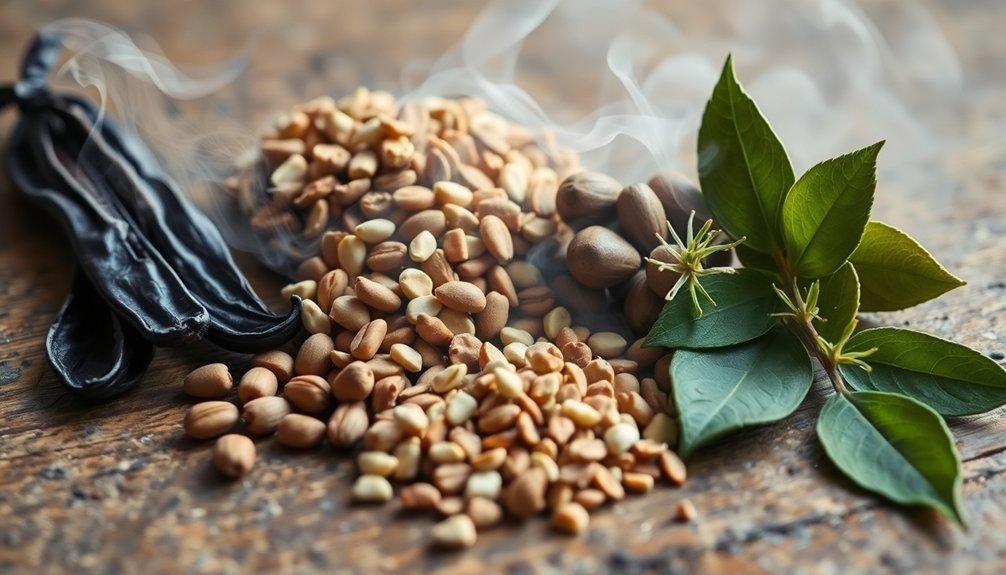
While natural musk has been prized for centuries in perfumery and medicine, its harvesting poses serious ethical and environmental concerns. The fragrant substance, primarily composed of macrocyclic ketones like muscone, comes from endangered musk deer species that have been devastated by poaching.
You'll find that natural musk's complex chemical makeup includes steroids, lipids, and water-soluble components that contribute to its unique properties. Common synthetic alternatives like galaxolide and tonalide have been developed to mimic these properties.
However, the international community has banned its trade through CITES regulations due to the cruel harvesting methods and the threat to musk deer populations.
That's why you need to explore alternatives. The fragrance industry has developed synthetic musks that can replicate the desired scent while avoiding the ethical issues associated with natural musk harvesting.
Safe and Legal Botanical Musk Substitutes
You'll find several effective plant-based alternatives to deer musk, with ambrette seed and labdanum leading the way as premier botanical substitutes.
These natural ingredients can produce complex, musky accords when properly blended, offering both ethical and sustainable options for your DIY fragrances.
The fragrance industry's commitment to ethical sourcing practices has driven the development of these botanical alternatives.
Plant-Based Musk Sources
For those seeking ethical alternatives to deer musk, plant-based sources offer compelling and sustainable options.
You'll find that nature provides several remarkable botanical ingredients that can create rich, musky scents without harming animals.
- Ambrette absolute, derived from hibiscus seeds, delivers a green, musky scent that's perfect as a base note in your DIY fragrances.
- Angelica root brings warmth and depth with its earthy, musk-like character.
- Labdanum, extracted from Cistus ladanifer, provides a rich, resinous aroma that acts as an excellent fixative.
- Ylang ylang contributes floral and slightly musky notes while adding a velvety smoothness.
You can combine these ingredients to create complex, long-lasting fragrances that rival traditional musk while maintaining ethical and sustainable practices. These natural alternatives serve as excellent fixatives in perfumery, helping to stabilize more volatile fragrance notes in your compositions.
Creating Natural Musk Blends
Creating your own natural musk blends requires careful consideration of complementary botanical ingredients that work in harmony.
You'll find that ambrette seed serves as an excellent foundation, offering a musky, nutty profile that closely mimics traditional deer musk.
To enhance your blend's depth, combine labdanum's warm, earthy notes with tonka bean's sweet undertones.
Add a touch of vetiver for additional earthiness, or experiment with sandalwood to achieve a richer, more complex scent profile.
These botanicals can be layered in varying proportions until you achieve your desired musky aroma.
For best results, start with small quantities and adjust gradually.
Remember that natural ingredients often have subtle variations, so you'll need to test and refine your blend several times before reaching the perfect balance.
Synthetic White Musk Options for Home Perfumers

When working with synthetic white musks in DIY perfumery, you'll find that macrocyclic compounds offer the safest and most reliable options for home use.
You can experiment with commercially available synthetic white musks like Galaxolide or Cashmeran, which provide clean, long-lasting base notes without the ethical concerns of natural musk.
These synthetics blend exceptionally well with other fragrance components, allowing you to create sophisticated layered scents while maintaining control over the intensity of your musky notes.
Safe Macrocyclic Musk Compounds
While traditional deer musk remains controversial and heavily restricted, macrocyclic musk compounds offer home perfumers a safe and ethical alternative for creating luxurious fragrances.
You'll find these synthetic musks provide warm, sweet, and sensual notes that closely mirror natural skin scents.
When working with macrocyclic musks in your DIY perfumes, consider these lab-tested options:
- Muscone for its rich, powdery base notes
- Ambrettolide to achieve a subtle, skin-like warmth
- Ethylene brassylate for its versatile fixative properties
- Natural ambrette seed as a botanical complement
These compounds have been thoroughly tested for safety and won't accumulate in body tissues like older synthetic musks.
You'll get consistent results while maintaining ethical standards, making them ideal for your home perfumery projects.
Blending White Musk Notes
Dedicated home perfumers seeking to blend white musk notes can explore a range of synthetic options that deliver clean, soft, and powdery scents. You'll find that synthetic white musk compounds offer consistent results and ethical alternatives to natural musk. When blending, start with popular molecules like galaxolide or ethylene brassylate, then experiment with different combinations to achieve your desired effect.
| Compound | Scent Profile | Best Combined With |
|---|---|---|
| Galaxolide | Clean, powdery | Florals, vanilla |
| Musk Ketone | Warm, sweet | Woody notes |
| Ambrettolide | Delicate, fruity | Light florals |
| Ethylene Brassylate | Soft, creamy | Oriental notes |
| Musk Xylene | Powerful, sweet | Spicy accords |
Remember to use white musk as both a fixative and a harmonizing element in your compositions, as it helps extend longevity while bringing cohesion to your fragrance blend.
Creating Black Musk Effects With Plant-Based Materials
Creating a black musk effect with plant-based materials requires strategic layering of rich botanical ingredients.
You'll find that labdanum provides the perfect foundation with its dense, resinous character that mimics the warmth of traditional black musk.
- Start with labdanum as your base, then add ambrette absolute for its clean, skin-like qualities.
- Layer in angelica root to introduce herbal musky facets that deepen the scent.
- Blend with sandalwood or patchouli to enhance longevity and ground the fragrance.
- Age your mixture to develop a more complex, nuanced aroma.
You can further intensify the black musk effect by incorporating tobacco and rose notes.
While these plant-based alternatives may cost more than synthetics, they'll provide a more authentic and sophisticated fragrance profile.
Ethical Animal-Derived Alternatives Like Hyraceum
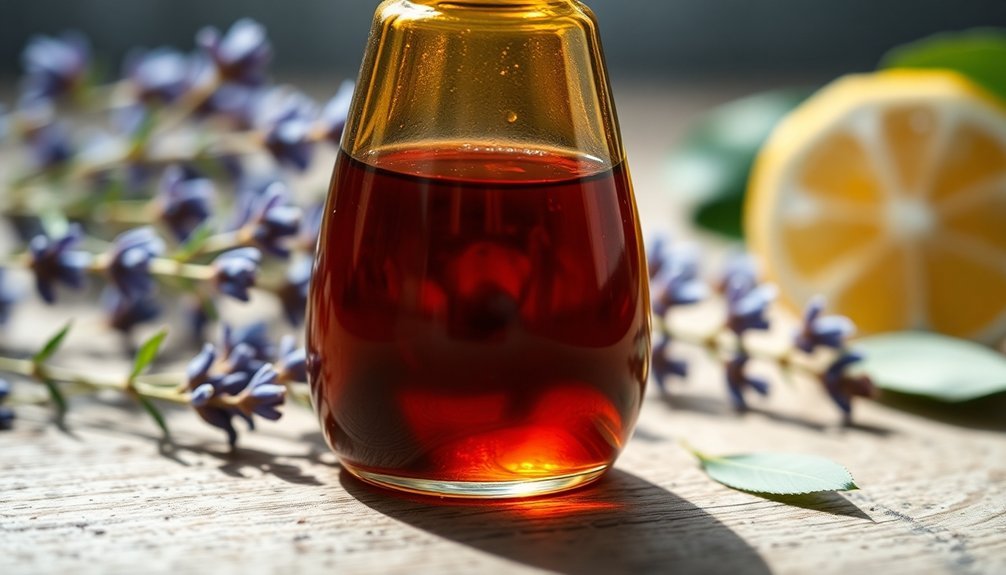
Among ethical alternatives to deer musk, hyraceum stands out as a fascinating option derived from fossilized Rock Hyrax excrement.
You'll find this "Africa Stone" offers a complex scent profile that combines elements of musk, castoreum, tobacco, and agarwood, making it an excellent deer musk substitute.
To use hyraceum in your DIY fragrances, you can work with either the resinoid absolute or create a tincture using a 1:3 ratio of hyraceum to alcohol.
You'll need only small amounts, as it's highly potent and acts as an effective fixative.
What makes hyraceum particularly appealing is its cruelty-free nature – it's harvested from cave deposits without harming any animals, though you should note it's a non-renewable resource that forms slowly over time.
Essential Oil Blends That Mimic Musk Notes
Natural perfumers seeking musk alternatives often turn to essential oil blends that masterfully recreate the coveted scent.
You'll find that plant-based ingredients like amber, patchouli, and vetiver can create rich, warm profiles reminiscent of traditional musk.
To craft your own musk-like blend, consider these essential combinations:
- Mix amber with musk ambrette seed for a sweet, powdery base
- Combine vetiver and patchouli for deep, earthy undertones
- Add ginger to create warmth and spicy complexity
- Layer multiple oils to achieve the desired sensual, skin-like aroma
You can apply these blends to pulse points, diffuse them in your space, or incorporate them into bath products.
Brands like PureomEO™ and Ajne offer pre-made botanical musk alternatives if you prefer ready-to-use options.
Combining Natural Resins for Musk-Like Fragrances

Beyond essential oil blends, resinous materials offer another powerful approach to crafting musk-like fragrances.
You'll find that natural resins like benzoin, myrrh, styrax, and labdanum can create rich, complex aromas that closely resemble musk notes.
Try combining benzoin with myrrh to achieve a deep, balsamic sweetness with hints of vanilla and licorice.
For a more animalic quality, blend styrax with labdanum to create an earthy, leathery undertone.
You can also experiment with frankincense and tolu balsam, which together produce a warm, balanced fragrance with woody and floral facets.
When working with these resins, you'll need to carefully balance the sweet and woody elements to create a harmonious composition that captures musk's distinctive character.
Preserving Your DIY Musk Alternative Blends
Once you've crafted your perfect musk alternative blend, proper storage becomes essential for maintaining its quality and potency.
You'll want to guarantee your creation stays fresh and aromatic for as long as possible.
- Transfer your blend into dark amber bottles, which protect the essential oils from light damage and help preserve their pure scents.
- Store your bottles in a cool, dark place away from direct sunlight and heat sources to prevent oxidation and allow the alcohol scent to fade naturally.
- Always use air-tight containers with secure caps to prevent contamination and maintain the fragrance's consistency.
- Let your blend mature for at least 48 hours before use, though waiting a month will yield the best results as the oils meld together and develop a richer, more complex aroma.
Sourcing Quality Materials for Musk Substitutes

When creating high-quality musk alternatives, sourcing reliable materials becomes essential for achieving authentic fragrances.
You'll find that botanical options like ambrette seeds, while expensive at $28,000 per kg, offer the most natural musk-like scent. If you're working with a tighter budget, consider labdanum or angelica root as more affordable natural alternatives.
For consistent results, you might opt for synthetic musks like galaxolide or tonalide, which cost around $800 per kg and are readily available year-round.
When purchasing your materials, verify you're working with reputable suppliers who can confirm the authenticity and quality of their products.
Remember that ethical sourcing matters – all your ingredients should comply with CITES regulations to support sustainable perfumery practices.
Frequently Asked Questions
How Long Does It Take to Develop a Musk-Like Scent Through Fermentation?
You'll need 6 months to 3 years for developing a musk-like scent through fermentation. The process requires patience as you'll see gradual changes, with the full aroma emerging after extensive aging.
Can Synthetic Musks Trigger Allergic Reactions in Sensitive Individuals?
Yes, if you're sensitive to synthetic musks, you can experience allergic reactions including skin irritation, breathing problems, nasal congestion, and eye issues. These reactions may range from mild to severe.
What Temperature Should I Store My Botanical Musk Blends At?
You'll want to store your botanical musk blends below room temperature, ideally between +4 to +8 degrees Celsius. Keep them in a cool, stable environment, but you don't necessarily need refrigeration for proper storage.
Do Musk Alternatives Perform Differently in Oil-Based Versus Alcohol-Based Formulations?
Yes, you'll notice distinct differences. Oil-based formulations offer longer-lasting scents and better skin compatibility, while alcohol-based ones give you immediate, bold fragrance impact but don't last as long on your skin.
How Can I Test the Longevity of My DIY Musk Alternatives?
You can test your musk alternatives through accelerated stability testing, light exposure trials, and real-time wear tests. Track the scent's strength over time and document how it performs in different temperatures and conditions.
In Summary
You've got plenty of ethical options to create that coveted musk scent in your DIY fragrances. Whether you choose botanical ingredients like ambrette seed, synthetic white musks, or natural resins, you'll find a combination that works for your perfume projects. Keep experimenting with different ratios and blends until you achieve that perfect musky base note that makes your creations unique and cruelty-free.

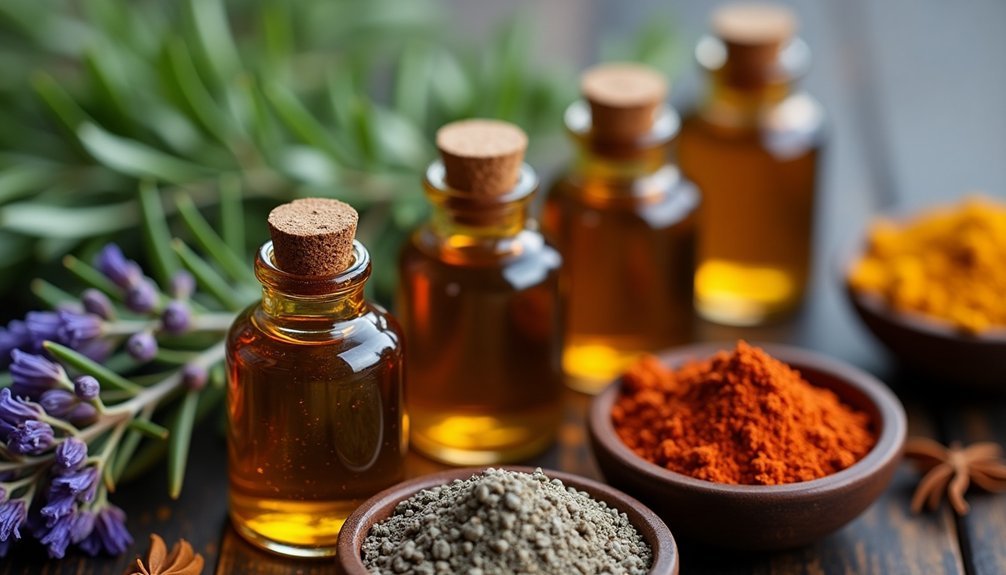
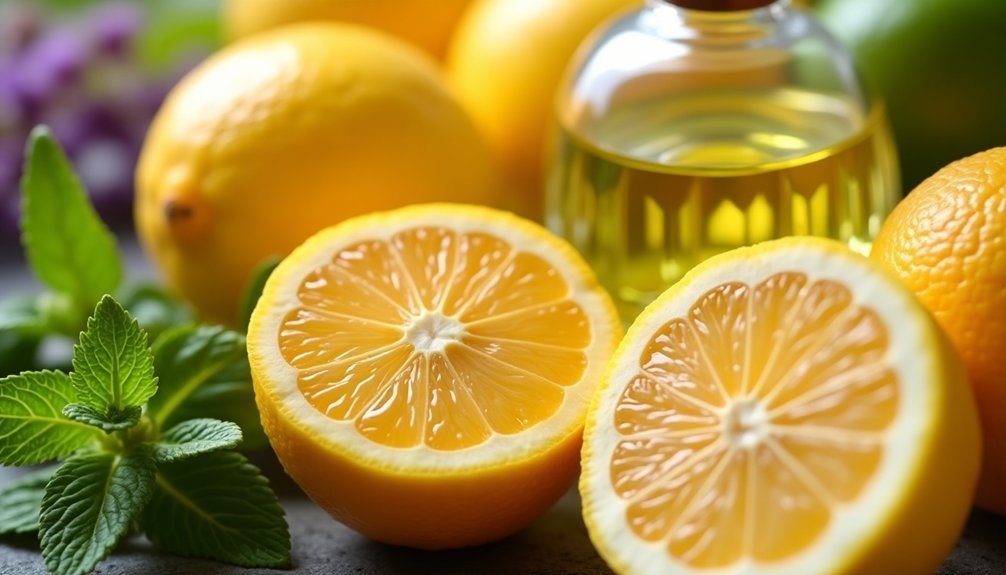
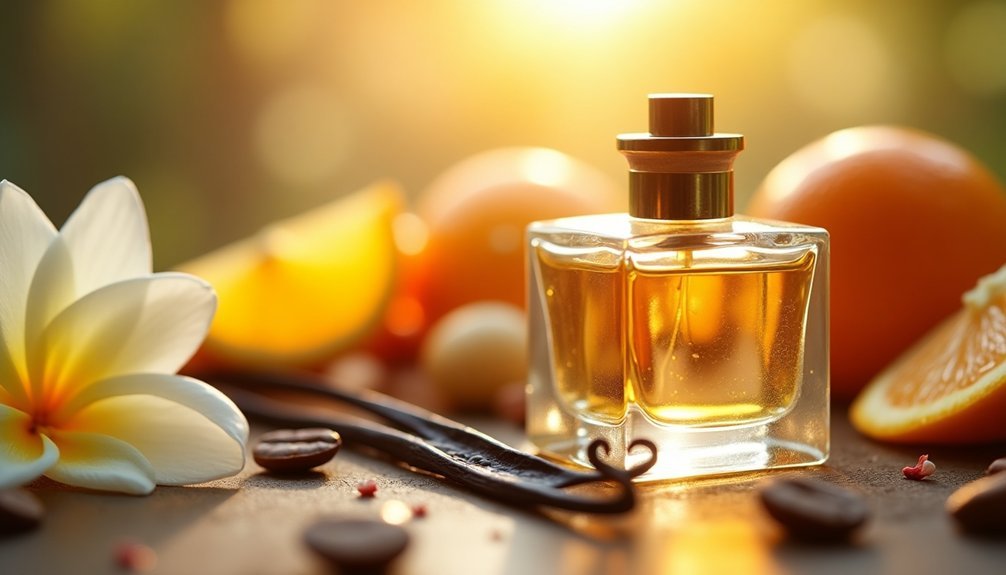

Leave a Reply